Visit your favourite destinations |
| A Report from birdtours.co.uk |
Canary Islands, Dec/Jan 1999/2000,
by Henning Fedders
&
Frank Rheindt
Am Dom 17 Breslauer
Str. 8
24109 Melsdorf 74336
Brackenheim
GERMANY GERMANY
sfedders@t-online.de formicarius@hotmail.com
Introduction:
General Information:
The Canary Islands are well-known amongst ornithologists for their handful of endemic landbirds that are more or less confined to this archipelago, complemented by a few so-called Macaronesian endemics which can otherwise only be found on the Azores and on Madeira to the north of the Canaries. In addition, these islands boast scores of seabird colonies, and they even constitute one of the main breeding grounds of one pelagic restricted-range species that can hardly ever be seen outside the Macaronesian region: the Madeiran Storm-Petrel, which otherwise occurs only on Madeira and a couple of other islands in the general vicinity. Furthermore, the Canaries attract dozens of North American stragglers every year, especially the more humid western islands, while the dry eastern islands hold a few North African desert specialties and can be good for western Palearctic migration.
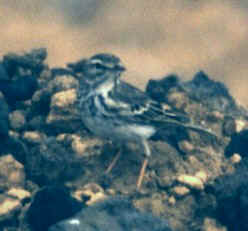
Berthelot's Pipit (Anthus berthelotii),
Amarilla Golf and Country Club, Tenerife, December 1999
photo by Henning Fedders
The islands:
To see all the endemics and near-endemics as well as nearly all the other specialties, and to get the best chances of seeing some North American rare in addition, one has to visit only two islands: Tenerife in the west and Fuerteventura in the east. Here is a little bit of additional information on the remaining islands, which will not be the subject of the main bulk of this report:
El Hierro and La Palma:These two islands constitute the westernmost end of the archipelago and are by far the most humid ones. They can only be reached by ferry from Tenerife, since there is no airport on either of them. The extensive areas of laurel forest that can still be found in parts of these islands make them the world stronghold of the White-tailed Pigeon, which can otherwise only be seen on Gomera and (in very low numbers) on Tenerife. But all the other laurel endemics and specialties, like Bolle's Pigeon or Canary Kinglet, should also be found with relative ease. These islands are undoubtedly excellent for North American stragglers, especially in September/October, but the low density of observers has accounted for a relatively disappointing total so far. While North American songbirds could just turn up anywhere, you can narrow down your choice of sites to look for waders (fall) or ducks (winter) to just a few artificial lakes scattered over the islands, and a visit at the right time of the year is bound to be successful. La Palma is the only island within the archipelago that harbors a few pairs of Chough. Unfortunately, the islands lack two endemics, the Blue Chaffinch and the Canary Chat.
Gomera: Similar in character to El Hierro and La Palma and just a few minutes by ferry from Tenerife, this island has attracted many an ornithologist who has failed to find White-tailed Pigeon on Tenerife. The latter is much easier to find here than Bolle's Pigeon, the reverse of which is the case on Tenerife. This is therefore another one of the humid western Canaries that are especially noteworthy for their laurel forest bird communities, besides harboring a distinctive subspecies of Blue Tit. The same that has been said about North American stragglers on Hierro and La Palma can probably be applied to Gomera. Blue Chaffinch, which is predominantly a pine forest species, as well as the scrub-dwelling Canary Chat are missing.
Gran Canaria: Situated in between the humid western and the two arid eastern islands, this island yields some characteristics of both, but apparently fails to do so in a dimension that would attract the endemic birds that depend on the respective habitats. The island is probably the one boasting most tourists and most tourist facilities in the archipelago, closely rivaled by Tenerife and in recent times Fuerteventura, but the laurel forests and their birds seem to have been gone long before the first tourists came. The only resident (near-)endemic bird apart from the omnipresent Canary Finch and Berthelot's Pipit is a tiny population of a distinctive subspecies of the Blue Chaffinch, the nominate race of which can be seen far more reliably and in plentiful numbers around Mount Teide on Tenerife. On the other hand, the aridity prevailing on other parts of this island doesn't seem to suffice for the handful of desert specialists occurring to the neighboring east.
Lanzarote:
Almost identical to its big southern neighbour Fuerteventura, this desert island
is one of the most reliable spots on earth to see Houbara Bustard, in addition
to its sharing all other desert specialties with Fuerteventura (Cream-colored
Courser, Black-bellied Sandgrouse...). It is the favorite island of a great
proportion of native Canarian ornithologists, who have mostly deprived themselves
of their interest in their own endemics over the years and who are now mainly
keen on finding Palearctic and North African rarities around their arid eastern
shores. Lanzarote doubtless offers a key position for turning up some scarce
migrant in spring or fall, but it does have one major drawback: despite the
availability of supposedly suitable habitat, it lacks the Chat, with which its
southern neighbor Fuerteventura seems to be well endowed for some reason. As
a matter of fact, it appears to lack all the endemics that are a little fussy
about their habitat.
A working knowledge of English or German seems to suffice, even though a little bit of Spanish is always of great advantage and can sometimes open locked doors. The climate is hot and dry in the northern summer, and just a little bit cooler and wetter in winter, although Lanzarote and Fuerteventura always seem to be arid, while the westernmost islands have been reported to be rainy in summer as well. Within the island of Tenerife, a distinction can be made between the drier south and the wetter north.
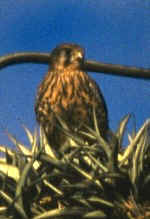
Kestrel (Falco tinnunculus canariensis)
Amarilla Golf and Country Club, Tenerife, December 1999
photo by Henning Fedders
The budget strategy
This trip report should be especially useful if:
- you plan on going in winter
- you have little money
- you have little time
As mentioned earlier, only two islands have to be visited
in order to see all the Canarian and Macaronesian endemics: Fuerteventura (the
only place where Canary Chat can be seen) and Tenerife (where all the other
endemics occur). Luckily, even all the non-endemic specialties which can regularly
be seen on the Canaries occur on one or either of these two islands (maybe with
the single exception of the Chough on La Palma).
For those who have little time to their disposition, it can be said that one
well-planned week is likely to suffice in order to see all the goodies.
Intra-insular transport:
Most of your time should be spent on Tenerife, as this
is the place where most of the endemics are to be found. That's why it is best
to fly directly to Tenerife and have that island as a base for potential ventures
to other islands, particularly Fuerteventura. If money is no problem, take one
of the convenient and costly planes from Tenerife's northern (domestic) airport
to Fuerteventura. The cheap alternative, however, is to go to the port of Santa
Cruz de Tenerife right after your arrival to Tenerife, so as to find out on
what days there are direct boats to Morro Jable (Fuerteventura). Even though
Fuerteventura can be reached on any day on boats that run via Gran Canaria,
direct boats to Fuerteventura are only on one or two days of the week. As timetables
seem to change frequently, it is important for you to know what day you have
to prepare to go on. Otherwise, the stop-over in Las Palmas (Gran Canaria) will
cost you one night on your way there plus one night on your way back, which
may amount to a loss of anything from 1 to 2 days of precious birding. The company
with the lowest prices and the highest boat frequencies appeared to be ARMAS
(about $60.- for a boat ride to Morro Jable and back with a stop-over in Las
Palmas (Gran Canaria)), but check out the others as well.
Accommodation and land transport:
Accommodation is a real problem for anyone who has ever
done some serious birding in the real world, outside of tourist hotspots. If
you think there will be no problem in just going there and looking for new accommodation
every night as you go along, possibly even near the bird site you wish to visit
on the next day, you will certainly be discouraged from holding on to that wrong
concept in this report. The islands are ripe with hotels, but almost all of
them seem to be either excessively expensive or exclusively designated to people
who have booked in advance in their home country. You may end up searching for
6 hours and ending up without a hotel room. Cheap hostals are few and far in
between and therefore ALWAYS full. Their presence indicates whether a town had
been there for longer than 20 years, so you can imagine that they will surely
not increase in number in the future.
The budget birder's first decision is whether he wants to rent a car or not.
Renting a car is certainly the best choice for any birding party of two or more,
but even as a lonesome traveler who doesn't mind spending the night in a car,
it really pays to rent one, since they're not really that expensive at $150.-
per week (beware of over-priced car offers at the airport and take a taxi to
Las Américas first when landing in southern Tenerife). It should be noted that
a car is more or less a necessity for anyone who plans on seeing all the endemics
within a short time. People who are certain they will rent a car should seriously
consider taking advantage of the cheap package tours to Tenerife (incl. flight
and hotel) offered in their European home countries. Don't get deterred by the
fact that you will have to stay at the same hotel every night and that you might
therefore miss out on a few distant sites, since all corners of the island can
conveniently reached from anywhere within little time through the island's excellent
two-laned motorway which runs almost all the way around the island. If money
is a real problem and you don't mind camping, do bring your tent, as there is
a (comparatively) cheap campground just a few kilometers from the southern (international)
airport. If you haven't booked a hotel in advance and you prefer a tent over
a car-seat, bring your tent anyway, just in case...
If planning a one-to-three-day trip to Fuerteventura from Tenerife, make sure
you know where to spend the night(s) BEFORE you arrive in Morro Jable by ferry,
as the accommodation situation is even more desolate here than on Tenerife.
All the towns on Jandía Peninsula are more or less booming tourist resorts without
any traditional cheap accommodation, and you will not do yourself a favor trying
to find a room by just knocking on the hotel doors. Our suggestion for those
budget birders who only have very limited time is to camp on the edge of the
desert plain (see "sites" below) where most goodies can be seen, which
guarantees you an early-morning start and the best chances of seeing all the
specialties within one day.
Sites
Tenerife:
Center:
Pico de Teide, the highest of all Canarian mountains, looms over Tenerife's center like a giant. Its snow-clad peak barely rises above the clouds that shroud its partly barren, partly wooded slopes most of the year. The improbably moon-like landscape that can be found above the tree line, close to the crater's rim, is a must even for the most single-minded beach tourist, and the convenient roads that give access to the summit region and thus to all elevational zones, have probably attributed to rendering this volcano the arguably most popular natural attraction of the archipelago.
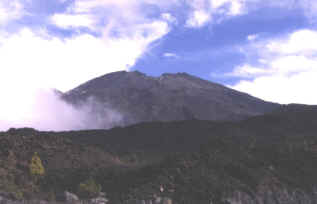
Pico de Teide, Tenerife, December 1999
photo by Henning Fedders
Birders would do well spending some time here, not just for the great vistas to be had in the ornithological wasteland around the crater region, but also for the fact that the archipelago's only strict pine endemic, the Blue Chaffinch, can only be seen here with great ease.
Strategy: To see the Blue Chaffinch, stop at any of about a dozen picnic areas (=zonas recreativas) that can be found in the pine forest zone along the three access roads to the summit region. An area that has been particularly productive in the past (according to many sources) is the Zona Recreativa de Las Lajas, just a few kilometers beyond the Teide National Park's entrance sign when coming from the south (Las Américas or southern airport). You should be able to find the birds within just half a minute after getting out of your car. But they can be seen equally well just anyplace where you are allowed to stop your vehicle within the pine forest.
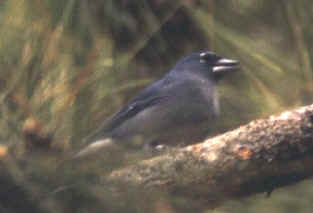
Blue Chaffinch (Fringilla teydea teydea)
Pico de Teide, Tenerife, December 1999
photo by Henning Fedders
Tip: The pine zone harbors a few other birds worth
looking for; the majority of them are just as easy or even easier to see in
most other habitats of the island's wet north, like the (soon-to-be-split-off)
Canarian Chiffchaff, the Canarian subspecies of the Blue Tit
or the Canary (Finch). The Tenerife Goldcrest, however, is otherwise
only distributed in laurel forest habitat, and even though they are far more
densely-populated there than in the pine zone, we found them to be considerably
harder to see in the dense deciduous canopy of the laurel sites we visited,
while the pine forest's open character greatly facilitated getting a glimpse
of them. This might be particularly relevant to people with a crowded schedule
who can only invest a few hours per site. In winter, the best strategy to find
a Goldcrest should be to park your car at Las Lajas, walk down one of the trails
from there and pay close attention to the high-pitched whispers of any mixed
flock of insectivores moving through the coniferous canopy; most birds will
turn out to be Blue Tits, but a little bit of searching should also reveal Chiffchaffs
and Goldcrests.
THE SOUTH
A) El Médano
El Médano, a little village on Tenerife's south coast
(just a little north-east of the international airport), can conveniently be
reached through the island's motorway. Even though not a real highlight for
birders, the rocky bays just west of town particularly the awe-inspiring red
rock - Montana Roja are always worth a quick look: At the bottom of the Red
Rock's eastern side, there is a small coastal lagoon that can be viewed from
above. Park your car near where you can see the tower of an abandoned airfield
and walk across towards the beach. The lagoon should always be good for a few
shorebirds (check for surprises), that might not be picked up elsewhere on the
island during your stay like in our case Kentish and Ringed Plovers. The thing
that makes Montana Roja most interesting is the large numberof gulls roosting
around there at least in winter. They can sometimes be seen on or near the beach
between El Médano and the rock, especially earlier in the morning. Towards the
afternoon, they seem to move a few hundred meters offshore, and they can then
be seen west of the rock as well, albeit harder to identify due to the greater
distance and the bad light conditions (that's the only way we saw them). That
flock of roosting gulls has been good for rarities like Auduoin's Gull in the
past, but you can imagine that these are ticks you have to work hard for, so
bring a scope!
The dry scrub around the big parking area half a kilometer west of the Red Rock
and the adjacent beach were good places to pick up Spectacled Warbler,
Southern Great Grey Shrike, and a few waders on our trip.
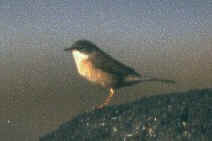
Spectacled Warbler (Sylvia conspicillata orbitalis)
Montana Roja, Tenerife, December 1999
photo by Henning Fedders
Soon upon arrival to the island in winter, the gull-maniacs among birders will notice the relative scarcity of gulls along the coast compared to western/central Europe. If you are keen on scanning through flocks of gulls, you should take advantage of any opportunity that comes along, since there won't be too many. Another place where you can see aggregations of gulls with relative ease is the port of Las Galletas, a coastal village between El Médano and Los Cristianos, where we did not see as many individuals as in El Médano, but where they could be seen from a much closer distance. Be prepared to leave without having seen any rarity; but even the two species present (Yellow-legged's atlantis-subspecies and Lesser Black-backed's graellsii-subspecies), especially their immature plumages will be a real challenge to the average European birder.
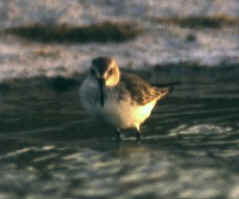
Dunlin (Calidris alpina)
Amarilla Golf and Country Club, Tenerife, December 1999
photo by Henning Fedders
B) Golf Courses "Golf del Sur" and "Amarilla Golf and Country Club"
Drainage and the presence of artificial ponds within the fairly dry setting of Tenerife's southern half are probably the factors that account for the relative wealth of birds to be found around these two golf courses. They are within sight distance of one another and can easily be reached on the fairway by taking the exit San Miguel, continuing towards Los Abrigos and following their signs. Look out for any security guards and keep clear of them, especially on the slightly more modern Golf del Sur, less so on Amarilla, as they will almost inevitably throw you off the course. Even though the two courses should generally be of equal quality, the far more productive of them turned out to be Amarilla, where a large barren area not used by the golfers can be found just left of the road before you enter the club house parking lots (to the right of the far side of the fairway that is behind the little pond left of the road). This area regularly attracts large flocks of larks: Lesser Short-toeds should be found year-round, while we also spotted a wintering flock of Skylarks which also consisted of one Greater Short-toed Lark mixed in between them. The larks (no matter what species) are generally very well camouflaged and are only likely to be encountered if you search through the area thouroughly and pay attention to where any calls faint calls come from. Even that way, you will probably flush them before getting to see them, and it can sometimes be a pain in the neck to relocate them once they've landed a few hundred meters away. At the southern edge of this dry barren terrain surrounded by green golf courses there is an area of green herbaceous vegetation nourrished by the water dripping out of the holes of leaking hoses: this is where a winter visit should yield a big flock of Red-throated Pipits. According to Tony Clarke's excellent book "A Birdwatcher's Guide to the Canary Islands", the flock has been found to occur every year within the last few years either at Golf del Sur or here, which probably makes it the westernmost wintering ground of the species. Apart from this excellent spot, the fairways appeared rather uninteresting to us, which may not be the case during migration: Berthelot's Pipits are omnipresent, Spectacled Warblers can be seen as well, and the various ponds attract shorebirds and the Canarian supspecies of the Grey Wagtail. Always make sure you don't obstruct any golfers from doing what they've paid so much money to do for: chasing little white balls around artificial meadows in the heat of the noon. Any lack of attention can be punished either - at best - by the legitimate scolding of some white-dressed sportsman or by a golf ball in your head.
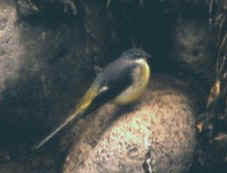
Grey Wagtail (Motacilla cinerea canariensis)
Amarilla Golf and Country Club, Tenerife, December 1999
photo by Henning Fedders
C) "Roquito del Fraile" and "Punta de la Rasca"
The arid climate prevailing in Tenerife's south leave
little reason to wonder why there aren't any natural, permanent bodies of water
to be found. The ornithologist is thus dependent on a score of artificial reservoirs
in his quest for waterbirds on the island. Most of these are little more than
man-made holes in the ground covered by layers of concrete and filled with water
that the average birder would rather shun if he/she didn't know better. A quick
look in winter confirms that they don't attract a whole lot of waterbirds, but
it is the second looks that often produce the (mostly Nearctic) rare that is
frequently mixed in between the low number of Eurasian ducks, waders and herons.
The only major reservoir in the island's south is the Roquito del Fraile, which
can be accessed by taking a left at the gas station half way between Las Galletas
and Guaza (as driving towards Guaza) and following the track along the edge
of a fenced-in banana plantation. Take the first track right, and follow it
until it ends near a barrier where you have to park your car and proceed on
foot straight through towards the scattered barns and from there on towards
the lighthouse (Faro de la Rasca). A few hundred meters beyond the barns a look
to your left should reveal a fenced-in tomato plantation and the reservoir's
concrete walls with a multitude of round holes in them that make the birding
a frustrating performance, as they are really too small for obtaining unspoiled
views with a scope or binoculars. We lucked out with a Lesser Scaup and
a Ring-necked Duck at the same time, while other winters are said to
have seen even larger numbers of long-staying North American wildfowl, both
in terms of species and individuals.The lighthouse itself is supposed to be
a good seawatching spot during hotter months of the year, while we felt that
one hour of seawatching was a wrong investment at the time of the year (December).
The general area around Punta de la Rasca is good for Spectacled Warbler
and Southern Great Grey Shrike.
THE NORTH
A) Reservoirs
We took a look at two more of those man-made reservoirs
in the north of Tenerife. These are the "Embalse de la Cruz Santa"
near Los Realejos on the one hand and the "Embalse de Valle Molina"
in the northeast of the island on the other hand. They seem to have been the
most productive of Tenerife's embalses in the past years as far as vagrants
are concerned. Both can be viewed marvellously from a track right above them.
For further details on how to get there, refer to Tony Clark's excellent field
guide. Another good idea is calling Tony as soon as you arrive on the island,
so he can inform you about any long-staying Nearctic winter visitor. The "Embalse
de Valle Molina" harbored a male American Wigeon and a Green-winged
Teal, when we visited them.
B) Monte del Agua
It is a must for every birdwatcher who visits Tenerife to see the two endemic pigeons: Bolle's and the much scarcer White-tailed Laurel Pigeon. The impressive laurel-clad slopes and glens around Monte del Agua are one of the most extensive remaining areas covered with relatively genuine Laurus habitat and are therefore one of the most reliable sites for these species. Between Erjos and El Palmar there is a road that passes directly through this habitat for more than 10 kilometres. Coming from Santiago del Teide, take a left just a few meters before the village of Erjos. The narrow road is not covered with concrete and you have to watch out for rock debris and mud, which could - at worst - make the road impassable for an average small car. If you have enough time anyway, it might be wise to enjoy the beautiful landscape of laurel forest by walking the whole stretch either from Erjos or from nearby El Palmar, where the chance to see Laurel Pigeons seems to be particularly good. But be prepared to get flight views only and take advantage of any vista point that comes along, since there will be just a few of them. In addition to the pigeons, the road along Monte del Agua is also good for Canary, Tenerife Goldcrest (albeit harder to see than in the relatively open pine forest), Sardinian Warbler and some of the Canarian races of widespread European species like Robin, Chiffchaff, Buzzard...
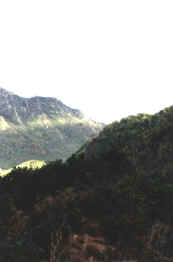
laurel forest near El Palmar, Tenerife, December 1999
photo by Henning Fedders
Besides Monte del Agua, there is a handful of other nice
laurel sites scattered over Tenerife's north where sightings of most of the
laurel specialties can probably be made with relative ease. However, not all
of these are home to the White-tailed Laurel Pigeon, the scarcest among all
the laurel endemics on Tenerife. According to some studies recently carried
out on Tenerife, their scarcity can be traced back to their ground-breeding
habits and the presence of rats on the island, while Bolle's Pigeon fares a
lot better in the presence of rats due to its tree-breeding habits. The western
island neighbors, which all harbor much healthier populations of this pigeon,
seem to be rat-free. Considering this, Monte del Agua will probably be the best
bet for this species on Tenerife because of its relative remoteness and big
extent. However, the Anaga Peninsula in the extreme north-east of the island
boasts some laurel that is similar in extent and pristinity to the one at Monte
del Agua, and Tony Clark's guide describes another site for White-tailed Laurel
Pigeons around here, which may be well worth a visit if you have not found the
species near Erjos or if you have enough time.
C) Punta de Teno
Punta de Teno, the northwestern headland of Tenerife,
may be the best seawatching-spot of the whole island, but in winter spending
time seawatching means wasting time even here. However this site has a special
fascination about it, not only on account of the remarkable occurrence of huge
flocks of Rock Sparrows in winter. The "Parque Natural Punta de
Teno" is signposted from Buenavista and is easily reached by car driving
along a nice road winding through a few coastal cliffs. Ignore the signs saying
this road is closed. At a few spots along the road, the bank widens and provides
space for people to park their cars. This is where you should spend a few minutes
scanning the cliffs for Barbary Falcon. After a few kilometers the road
leaves the cliffs and descends through an area of euphorbia scrub and tomato
plantations. The whole land north of the road should be watched intensively
with the object of finding the wintering flock of Rock Sparrows that seems to
comprise the whole Tenerifan population. Given the dimension of the flock we
saw, it is not surprising that we didn't see any Rock Sparrows in the northern
and western villages, where their summer breeding sites are located. Other species
in the area are Spectacled and Sardinian Warbler and even Barbary
Partridge for the lucky.
Fuerteventura
This arid island is the only place on earth to see the
Canarian Chat, and thus constitutes a must for all birders who don't want to
miss this strict Canarian endemic. Apart from that, the island boasts a few
inhabitants of arid habitats that can otherwise only be seen on Lanzarote (just
a bit north of Fuerteventura) within the archipelago.
A good area for getting them all is the peninsula of Jandía, the southernmost
part of the island. If you come to Fuerteventura by plane, there will be a few
other areas good for the desert birds and the Chat in proximity of the airport
(which is situated much more to the island's north). You would have to refer
to other reports or to Tony Clark's excellent site guide in order to find these.
However, if you decide to come here by boat from one of the western islands
(Tenerife or Gran Canaria), whether your motive be spending less money or taking
your chance of seeing a few nice pelagics, you will inevitably land in the peninsula's
main port Morro Jable, a great starting point from which to explore the island's
bird life. Even though you'd have to spend several days to do the area justice,
one day suffices for seeing all the specialties, including the Chat, which makes
Jandía the best and only choice for budget birders coming by boat.
You have to concentrate on two separate areas for seeing the goodies:
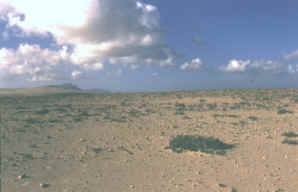
sandy plain near Costa Calma, Fuerteventura, January 2000
photo by Henning Fedders
A) sandy plain near Costa Calma (the desert site)
Some 20 or 30km north of Morro Jable along the main road
lies the beach resort of Costa Calma, an aggregation of expensive hotels and
bungalow complexes mainly frequented by German tourists. Just a few hundred
meters straight inland (north-west) from the last buildings on Costa Calma's
inland side, you hit upon a fence that encircles a large sandy plateau of nearly
4x4km in size. This is the place to spend some time at in order to see Black-bellied
Sandgrouse, Eurasian Thick-knee, Cream-colored Courser and Houbara Bustard.
The sandy plain extends all the way to the cliffs on the island's west coast
(around this part, the island is only a few kilometers wide anyway), while on
the left (south-western) side, the plain is abutted by the incipient ridges
of Jandía's mountain chain (marked by a wind park), and on the right (north-eastern)
side, the main road to the island's north delimits the plateau. There are a
few gates through which you can enter the area, but you can also climb/jump
over the fence wherever it's been lowered, since the fence is to prevent you
from entering the area with a vehicle, while trespassing on foot is tolerated
as long as it's being carried out judiciously.
Walking around the sandy plain for a few hours should allow for sightings of
all the above-mentioned species. If you have missed Lesser Short-toed Larks
on Tenerife, you will definitely see them here in great numbers. You should
also get to see plenty of Southern Great Grey Shrikes as well as a few
Spectacled Warblers wherever there are a few bushes in the semi-desert
habitat. If you only have one day on the island, come here first thing in the
morning and go to Pico de la Zarza (next site) later, since the morning hours
are better for most of the species involved. Houbara Bustard is probably
the trickiest one, and a scope will do a great deal to increase your chance
of seeing the species; our impression is that most Houbaras will be sighted
by scanning the plain with a scope rather than flushing them, while Thick-knees
and Coursers will most likely be flushed, so the most effective strategy
should be to cover as much ground as possible within a short time with frequent
stops to scan the plain. Sandgrouse are most often seen flying by, so
don't keep your eyes on the ground all the time. The area seems to be a good
address for surprises as well, which our sighting of 4 wintering Dotterels
undoubtedly attests for (they were in the company of Coursers).
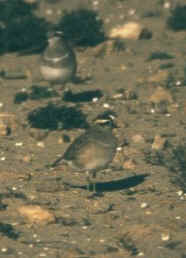
2 Dotterels (Charadrius morinellus)
sandy plain near Costa Calma, Fuerteventura, January 2000
photo by Henning Fedders
One tip: Do not just show up in Costa Calma hoping that
they will accommodate you somewhere; you'd have to book your accommodation in
your home country well in advance. We are sorry to say that the best way of
avoiding any bad surprises should be taking along your tent and setting it up
somewhere between the hotels and the plain on what appears to be non-private
ground where no-one should disapprove of that. Or just go ahead and make your
own very bad experiences with finding (or rather: not finding) an accommodation.
B) Pico de la Zarza (the Chat site)
If time is short and you have to be back at the boat
by the night, head straight back to the town of Jandía (which lends its name
to the peninsula) just a short distance north of Morro Jable along the main
road. Transportation during day-light is not a problem on the island, since
there are frequent tourist busses stopping at numerous bus stops scattered along
the road. At night time, you have to resort to taxis, in case you don't have
your own car or want to hitchhike.
Jandía beach itself is worth some birding. There are populations of Monk Parakeet
and various kinds of tropical Ibis to be found along the beach, and if it is
not for these feral gems, you might want to watch out for frequent flocks of
Uniform Swift or for migrant or vagrant songbirds in the various types
of "man-made" vegetation that make this place look so lush.
Or concentrate on what you are here for and head straight up on one of the two
trails/tracks that lead uphill towards the peninsula's highest peak named Pico
de la Zarza. One track ascends the slope left of the small valley that runs
inland from town, leading to some satellite station and from there on towards
the peak itself. This track can be accessed with vehicles at least part of the
way, while the right track is only suitable for hikers. (We don't know how far
a taxi would take you up the first track, or if it would enter at all). Don't
underestimate the task, and make sure you allow for sufficient time to get to
the Chat (which means: don't come here too late in the afternoon if time's
an issue): We thought it was going to be a short hike up to see the Chat in
the dry habitat abounding all over the slope, until we realized that the Chats
can only be seen above the line that marks the beginning of GREEN vegetation:
The hills' and mountains' peaks are all covered by xerophytic vegetation, but
(at least in winter) there is a pretty even line that seperates the green upper
slopes near the peak from the brown lower slopes that are covered by leafless
scrub vegetation. We managed to get to the green zone within a hell of a two
hours' hike - driven by the fear of missing the bird - and as soon as we entered
that zone, we instantly chanced upon several individuals (as well as Blue
Tits of the island's distinct "degener" subspecies). If
you want to do the whole thing on foot as well, allow for 3 hours to get to
the bird and 1 hour back. Other treats awaiting you on that mountain are Ravens
and Uniform Swifts.
Acknowledge anyone you might meet on the trail by grinning and saying "Scot",
a word sounding close enough to the hard-to-pronounce "Gruess Gott"
which the majority of people on the island obligingly use in their language
to greet any oblivious hiker that might come even within remote reach of their
voice radius.
Any birdwatcher visiting the Canary Islands should seriously consider buying Tony Clarke's and David Collins' outstanding site guide "A BIRDWATCHERS' GUIDE TO THE CANARY ISLANDS". If going in winter, it should also be advisable to email or call Tony Clarke once there, in order to find out about possible vagrants currently staying on the island.
Triplist (29.12.99 - 05.01.00)
| 1 | Gannet | Sula bassana | 2 ad., ferry from Las Palmas to Santa Cruz (04.01.00) |
| 2 | Cattle Egret | Bubulcus ibis | 4 Ind., Morro Jable, Fuerteventura (03.01.00) |
| 3 | Little Egret | Egretta garzeta | 1 Ind., Amarilla Golf Club (29.12.99) 1 Ind., Golf del Sur (30.12.99) 1 Ind., Embalse de Valle Molina (01.01.00) 1 Ind., Morro Jable, Fuerteventura |
| 4 | Grey Heron | Ardea cinerea | 1 Ind., Amarilla Golf Club (29.12.99) 1 Ind., Roquito del Fraile (30.12.99) 8 Ind., Embalse de Valle Molina (01.01.00) A few Ind., Embalse de la Cruz Santa (01.01.00) |
| 5 | Spoonbill | Platalea leucorodia | 1 immat., Roquito del Fraile (30.12.99) |
| 6 | Mallard | Anas platyrhynchos | About 4 Ind., Embalse de la Cruz Santa (01.01.00) |
| 7 | Shoveler | Anas clypeata | 3 female, Roquito del Fraile (29.+30.12.99) |
| 8 | American Wigeon | Anas americana | 1 male, Embalse de Valle Molina (01.01.00) |
| 9 | Teal | Anas crecca crecca | A few Ind., Roquito del Fraile (29.+30.12.99) |
| Green-winged Teal | Anas crecca carolinensis | 1 male, Embalse de Valle Molina (01.01.00) | |
| 10 | Ring-necked Duck | Aythya collaris | 1 female, Roquito del Fraile (29.+30.12.99) |
| 11 | Lesser Scaup | Aythya affinis | 1 female, Roquito del Fraile (29.+30.12.99) |
| 12 | Buzzard | Buteo buteo insularum | A few Ind., North Tenerife 1 Ind., Pico de la Zarza, Fuerteventura |
| 13 | Sparrowhawk | Accipiter nisus granti | 1 Ind., Monte del Agua (31.12.99) 1 Ind., Anaga Peninsula (04.01.00) |
| 14 | Kestrel | Falco tinnunculus canariensis | Common, Tenerife |
| Falco tinnunculus dacotiae | Common, Fuerteventura | ||
| 15 | Barbary Falcon | Falco peregrinus pelegrinoides | 1 ad., Masca (31.12.99) |
| 16 | Barbary Partridge | Alectoris barbara | 1 Ind., Punta de Teno (01.01.00) |
| 17 | Coot | Fulica atra | A few Ind., Roquito del Fraile (29.+30.12.99), Embalse de Valle Molina (01.01.00), Embalse de la Cruz Santa (01.01.00) |
| 18 | Houbara Bustard | Chlamydotis undulata fuertaventurae | 1 Ind., sandy plain north of Costa Calma, Fuerteventura (03.01.00) |
| 19 | Stone-curlew | Burhinus oedicnemus insularum | 6 Ind., sandy plain north of Costa Calma, Fuerteventura (03.01.00) |
| 20 | Cream-coloured Coursor | Cursorius cursor bannermani | 2-3 Ind., sandy plain north of Costa Calma, Fuerteventura (03.01.00) |
| 21 | Ringed Plover | Charadrius hiaticula | About 5 Ind., Montana Roja (30.12.99) |
| 22 | Kentish Plover | Charadrius alexandrinus | >5 Ind., Montana Roja (30.12.99) |
| 23 | Dotterel | Charadrius morinellus | 4 Ind., sandy plain north of Costa Calma, Fuerteventura (03.01.00) |
| 24 | Grey Plover | Pluvialis squatarola | 1 Ind., Roquito del Fraile (29.12.99) |
| 25 | Golden Plover | Pluvialis apricaria | 1 Ind., sandy plain north of Costa Calma, Fuerteventura (03.01.00) |
| 26 | Dunlin | Calidris alpina | 4 Ind., Montana Roja (30.12.99) 6 Ind., Amarilla Golf Club (31.12.99) |
| 27 | Sanderling | Calidris alba | About 10 Ind., Montana Roja (30.12.99) |
| 28 | Green Sandpiper | Tringa ochropus | 2 Ind., Embalse de Valle Molina (01.01.00) |
| 29 | Greenshank | Tringa nebularia | 4 Ind., Embalse de Valle Molina (01.01.00) |
| 30 | Common Sandpiper | Actitis hypoleucos | Common, Tenerife |
| 31 | Whimbrel | Numenius phaeopus | 1 Ind., Golf del Sur (29.12.99) 2 Ind., Montana Roja (30.12.99) |
| 32 | Woodcock | Scolopax rusticola | 1 Ind., Monte del Agua (31.12.99) |
| 33 | Black-headed Gull | Larus ridibundus | A few Ind., seen from the ferries and in the harbour of Las Palmas (02.-04.01.00) |
| 34 | Yellow-legged Gull | Larus cachinnans atlantis | Common at the coast of Tenerife and Fuerteventura |
| 35 | Lesser Black-backed Gull | Larus fuscus graellsii | Common at the coast of Tenerife and Fuerteventura |
| 36 | Kittiwake | Rissa tridactyla | 1 first-year Ind., ferry from Las Palmas to Santa Cruz (04.01.00) |
| 37 | Sandwich Tern | Sterna sandvicensis | 12 Ind., Las Palmas a few single Ind. around the islands |
| 38 | Black-bellied Sandgrouse | Pterocles orientalis | About 10 Ind., sandy plain north of Costa Calma, Fuerteventura (03.01.00) |
| 39 | Rock Dove | Columba livia | Common overall |
| 40 | Bolle's Pigeon | Columba bollii | Common, Monte del Agua (31.12.99) 1 Ind., Anaga Peninsula (04.01.00) |
| 41 | Laurel Pigeon | Columba junoniae | 2 Ind., Monte del Agua (31.12.99) |
| 42 | Collared Dove | Streptopelia decaocta | Common in large towns |
| 43 | Plain Swift | Apus unicolor | 2 Ind., Guargacho (29.12.99) about 5 Ind., Las Galletas (30.12.99) about 10 Ind., Jandía and Pico de la Zarza, Fuerteventura (03.01.00) |
| 44 | Hoopoe | Upopa epops | 4 Ind., Amarilla Golf Club (29.12.99) 1 Ind., Golf del Sur (30.12.99) 3 Ind., Costa Calma, Fuerteventura (03.01.00) |
| 45 | Great Spotted Woodpecker | Dendrocopus major canariensis | Common, Pico de Teide (31.12.99) |
| 46 | Skylark | Alauda arvensis | 12 Ind., Amarilla Golf Club (30.12.99) 1 Ind., Punta de Teno (01.01.00) |
| 47 | Short-toed Lark | Calandrella brachydactyla | 1 Ind., Amarilla Golf Club (30.12.99) |
| 48 | Lesser Short-toed Lark | Calandrella rufescens polatzeki | >10 Ind., Amarilla Golf Club
(30.12.99) common, sandy plain north of Costa Calma, Fuerteventura (03.01.00) |
| 49 | House Martin | Delichon urbica | 2 Ind., Jandia, Fuerteventura (03.01.00) |
| 50 | Berthelot's Pipit | Anthus berthelotii | Common overall |
| 51 | Red-throated Pipit | Anthus cervinus | >11 Ind., Amarilla Golf Club (30+31.12.99) |
| 52 | White Wagtail | Motacilla alba | 2 Ind., Amarilla Golf Club (29.12.99) |
| 53 | Grey Wagtail | Motacilla cinerea canariensis | Common, Tenerife |
| 54 | Robin | Erithacus rubecola superbus | Common, North-Tenerife |
| 55 | Canary Islands Chat | Saxicola dacotiae | 2,2 Pico de la Zarza, Fuerteventura (03.01.00) |
| 56 | Blackbird | Turdus merula cabrerae | Common, North-Tenerife |
| 57 | Blackcap | Sylvia atricapilla heineken | Common, Monte del Agua (31.12.99) |
| 58 | Sardinian Warbler | Sylvia melanocephala | 3-4 Ind., Monte del Agua (31.12.99) 3 Ind., Punta de Teno (01.01.00) A few Ind., Anaga Peninsula (04.01.00) |
| 59 | Spectacled Warbler | Sylvia conspicillata orbitalis | 1,1 Montana Roja (30.12.99) 2,0 Amarilla Golf Club (30.12.99) 3,0 Roquito del Fraile (30.12.99) >5 Punta de Teno (01.01.00) 1,0 sandy plain north of Costa Calma, Fuerteventura (03.01.00) |
| 60 | Chiffchaff | Phylloscopus collybita canariensis | Common, Tenerife |
| Phylloscopus collybita collybita | 1 Ind., Jandia, Fuerteventura (03.01.00) | ||
| 61 | Tenerife Goldcrest | Regulus teneriffae | 1-2 Ind., Las Lajas (31.12.99) Common, Monte del Agua (31.12.99) and Anaga Peninsula (04.01.00) |
| 62 | Blue Tit | Parus caeruleus teneriffae | Common, North-Tenerife |
| Parus caeruleus degener | 1-2 Ind., Pico de la Zarza, Fuerteventura (03.01.00) | ||
| 63 | Southern Great Grey Shrike | Lanius meridionalis koenigi | Common, South-Tenerife >2 Ind., sandy plain north of Costa Calma, Fuerteventura (03.01.00) |
| 64 | Raven | Corvus corax tingitanus | 2 Ind., Pico de la Zarza, Fuerteventura (03.01.00) |
| 65 | Starling | Sturnus vulgaris | 8 Ind., south of Amarilla Golf Club (29.12.99) |
| 66 | Spanish Sparrow | Passer hispaniolensis | Common in towns |
| 67 | Rock Sparrow | Petronia petronia madeirensis | about 100 Ind., Punta de Teno (01.01.00) |
| 68 | Chaffinch | Fringilla coelebs tintillon | Common, North-Tenerife |
| 69 | Blue Chaffinch | Fringilla teydea teydea | Common, Pico de Teide (31.12.99) |
| 70 | Linnet | Carduelis cannabina meadewaldoi | About 10 Ind., Punta de Teno (01.01.00) |
| 71 | Goldfinch | Carduelis carduelis | A few Ind., Costa Calma, Fuerteventura (03.01.00) |
| 72 | Greenfinch | Carduelis chloris | A few Ind., Pico de Teide (31.12.99) and Costa Calma, Fuerteventura (03.01.00) |
| 73 | Canary | Carduelis canaria | Common, North-Tenerife |
| (74) | Sacred Ibis | Threskiornis aethiopicus | 1 immat., Jandía, Fuerteventura (03.01.00) |
| (75) | Monk Parakeet | Myopsitta monachus | A few Ind., Jandía, Fuerteventura (03.01.00) |
Why not send us a report, or an update to one of your current reports?